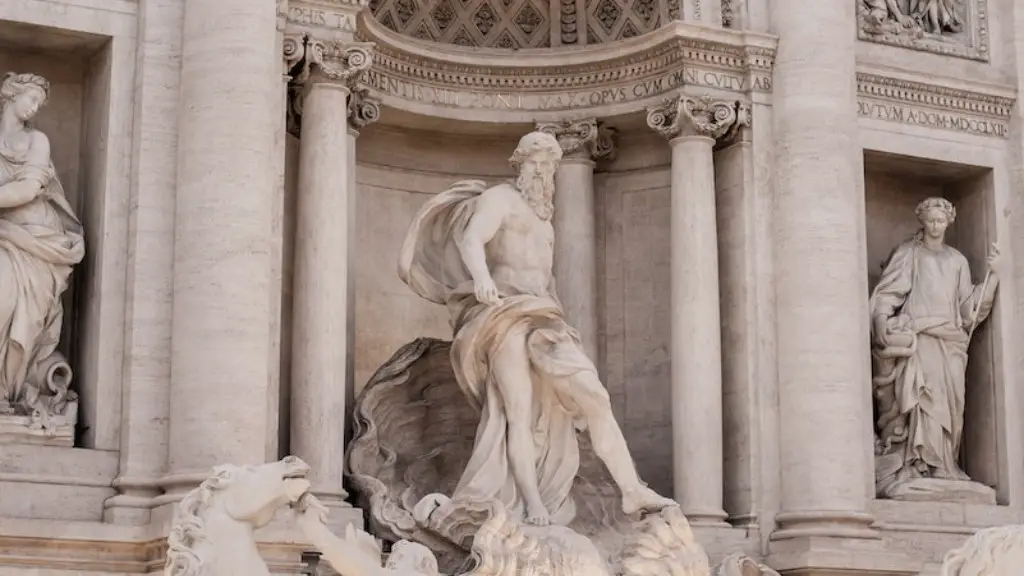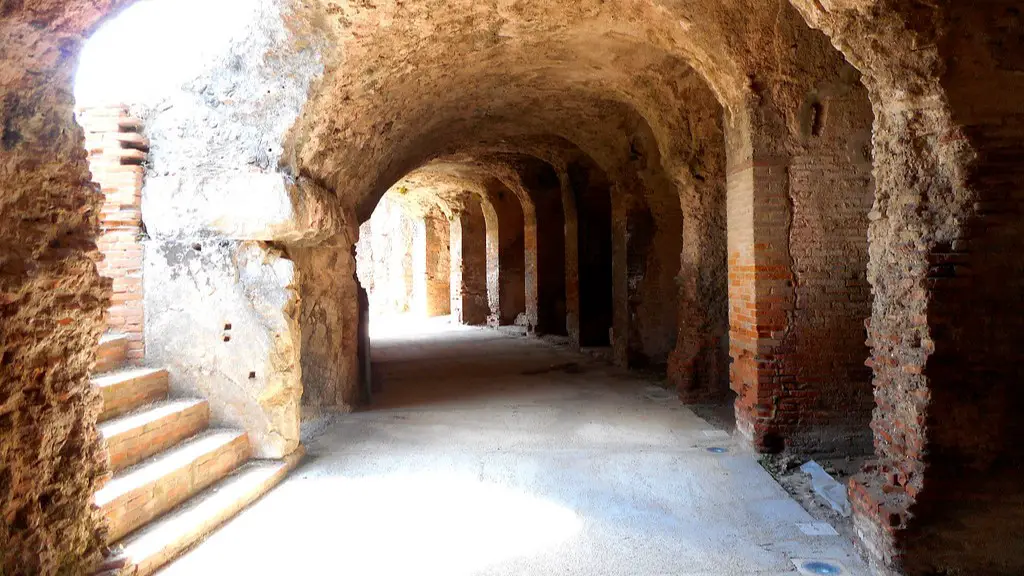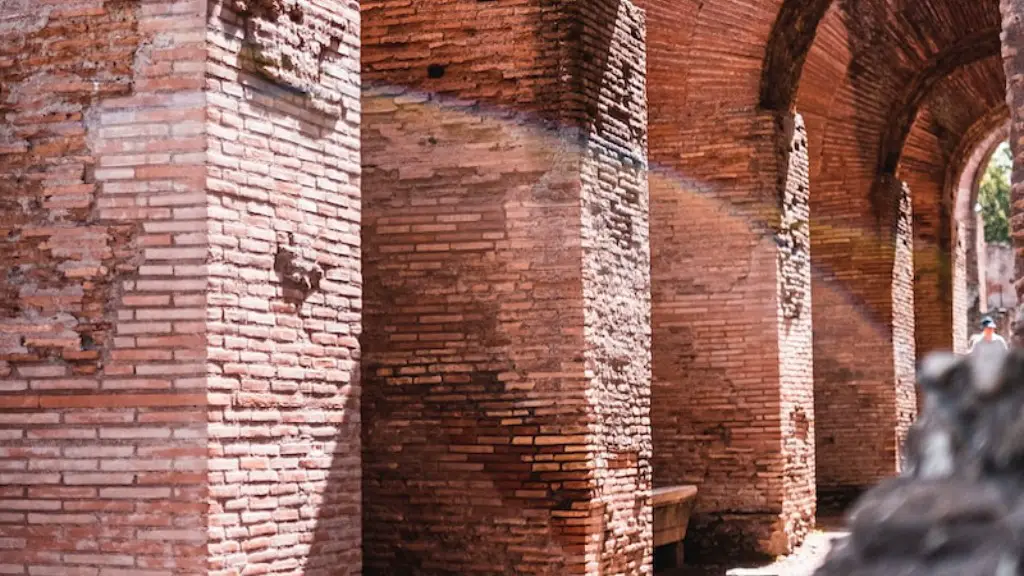When it comes to ancient Rome, it’s impossible to ignore the immense impact it had on society, culture and architecture. The Roman Empire began with the foundation of Rome in 753 BC and lasted for over a thousand years until it fell in 476 AD. Within this time, Rome grew to become one of the major powers of the world. Rome was not restricted to just one location, however, it had colonies and settlements across the Mediterranean region, which acted as major hubs for trade, religion and politics. This article will explore where exactly the ancient Romans lived, and the different types of cities and settlements they built.
The main area the ancient Romans lived in was the Italian Peninsula, the area of land which is now modern day Italy. The largest city from the Empire was Rome, located on the banks of the river Tiber in the Central-West of the peninsula. As the capital of the Roman Empire, Rome was the largest and most important city in the region, drawing in hundreds of thousands of people from around the world for trade, politics and religion. Beyond Rome, there were also many other cities and settlements scattered all throughout the Italian Peninsula.
As the Empire expanded, Rome began to build and control an array of cities and settlements outside of the Italian Peninsula. These settlements spanned out across the Mediterranean, forming an impressive network of Roman cities and towns. From Spain to the Middle East, the ancient Romans built a series of cities, settlements and trading posts that connected the Mediterranean region. Major cities like Milan, Gaul, Cairo and Carthage acted as vital hubs for religious, political and cultural exchange.
The ancient Romans were well known for their impressive architecture and building skills. The city of Rome itself was home to some of the most impressive buildings in the world such as the Colosseum and the Forum. Other major cities such as Milan, Gaul and Carthage were also decorated with towering monuments and grand statues. These cities quickly became centres of power and influence for the Roman Empire and the wider Mediterranean region.
The ancient Romans were also known for their advanced engineering skills which enabled them to construct many impressive works of infrastructure. Cities such as Gaul and Carthage were connected by a vast network of roads which allowed trade and travel to take place quickly and efficiently. The Romans also built impressive aqueducts and bridges to deliver clean water to their cities and settlements, as well as permanent defenses to protect them.
Urban Spaces
Aside from the major cities, the ancient Romans also constructed many different types of urban settlements. Hampers or vicus were a type of settlement found all across the Roman Empire. These settlements served as hubs for economic activity and could often contain a range of different buildings such as workshops, temples and warehouses. In some cases, hampers could even become cities themselves, such as Ravenna in Italy, which started out as a hammer before becoming a large city.
The ancient Romans also built fortified cities known as castra. These cities were usually encircled by a large wall or ditch and served as hubs for military defense. Castra could often contain barracks and other military buildings such as armories, as well as storage facilities for food and supplies. The largest castra were also equipped with gates to control access and towers to observe enemies from afar.
In addition to these cities and settlements, the ancient Romans also built a variety of towns and villages known as vici and oppida respectively. These towns and villages usually had a more rural character and were usually much smaller than the major cities of the Empire. Despite their size, the towns and villages could often contain a range of different buildings such as temples, granaries, workshops and homes. This allowed the ancient Romans to continue their economic, political and religious activities in their newly established towns and villages.
Agricultural Spaces
In addition to their urban and military settlements, the ancient Romans also established a number of agricultural settlements. These settlements ranged from large farms to small villages located in the countryside. The largest and most important of these settlements were the villas or latifundia, which were vast estates that acted as the central hub for a range of different agricultural activities. The estate would usually be self-sufficient and contain buildings such as homes for the workers, stables for animals and granaries for storing food.
The most common type of agricultural settlement, however, was the villa rustica which were small villages located in the rural areas of the Empire. These settlements usually had a population of around 100 to 200 people and often contained a range of different buildings and activities such as homes, workshops, storage facilities and small farms. The villa rusticas were also populated by exotic animals such as cows, chickens and pigs, which would be used for food and milk.
The ancient Romans were well aware of the natural resources in their given area and used them to their advantage. Methods such as crop rotation, the use of fertilizer and terracing the land allowed them to maximize their agricultural output. Many of these methods are still used in modern times and are a testament to the skill and resourcefulness of the ancient Romans.
Religious Spaces
The ancient Romans were heavily influenced by polytheistic beliefs, worshipping a range of different gods and goddesses. This polytheism was often expressed through the building of temples and sanctuaries across the Roman world. Major cities such as Rome, Milan, Gaul and Carthage had temples dedicated to gods such as Jupiter, Iona and Minerva. The temples were also often used to observe religious rituals and ceremonies, such as animal sacrifices and sacrifices of wine.
The ancient Romans also believed in divination, the practice of prophesying the future based on the interpretation of omens, and this was often done in oracular temples. In particular, the oracle in Delphi was thought to be especially powerful and consulted by many across the Roman world. Other than temples and oracles, the ancient Romans also had shrines and sanctuaries dedicated to the gods and goddesses. These shrines and sanctuaries often contained statues and other artifacts in honor of the deities.
As the Roman Empire expanded and came into contact with other cultures, the ancient Romans were exposed to a range of different religious beliefs and practices. This often led to a sort of religious syncretism in which elements of different religions were combined together. As a result, many of the gods and goddesses of the Roman world were also taken from other cultures, such as Isis from Egypt and Mithras from Persia.
Social Spaces
Within the cities and settlements of the Roman world, there were many places in which people could gather, socialize and take part in leisure activities. The main type of social gathering space in the Roman world were the public baths. Public baths were large complexes where the people of the city could come to relax, socialize, exercise and even enjoy a meal. Large cities such as Rome, Milan, Gaul and Carthage had extensive public bath complexes which often contained gymnasiums, swimming pools and other leisure facilities.
Aside from the public baths, the public spaces in the cities were also full of life and activity. Amphitheatres were large entertainment arenas, which were used to host gladiatorial games and other public spectacles. Public parks and gardens were also abundant, providing the people of the city with areas to relax and escape from the hustle and bustle of everyday life. Markets and agoras were also commonly found in the cities, allowing for the trade, bartering and purchasing of goods.
The gathering places of the Roman world were full of activity and diversity. Whether it was the public baths, amphitheatres or markets, these places allowed the people of the city to come together and take part in a variety of different activities. In this sense, the public spaces of the Roman world acted as a hub for the exchange of ideas and culture, helping to spread the ideas and beliefs of the ancient Romans across the Mediterranean region.
Conclusion
The ancient Romans lived a wide and varied life, inhabiting cities and settlements all throughout the Mediterranean region. From major cities such as Rome, to hampers and villa rusticas, the kingdom of the ancient Romans contained a diverse range of urban and agricultural settlements. The spiritual life of the ancient Romans was also regularly expressed through the building of temples, oracles and shrines. On top of this, the people of the Roman world had access to a variety of social spaces, enabling them to come together and exchange ideas and culture.




